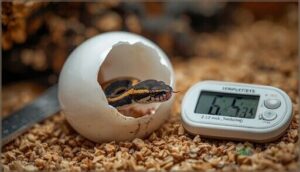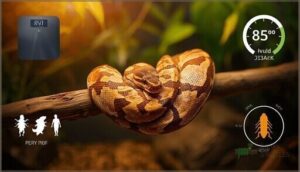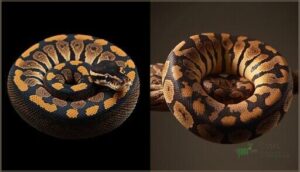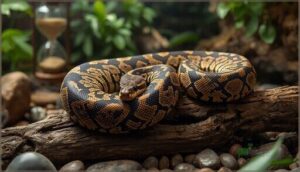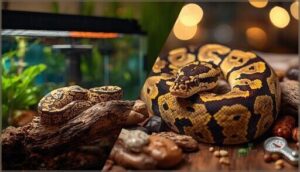This site is supported by our readers. We may earn a commission, at no cost to you, if you purchase through links.
 A ball python hatched in captivity today has a decent shot at celebrating its 30th birthday—potentially outliving most dogs, cats, and even some tortoises. That’s not a typo. These docile constrictors routinely reach three decades in proper care, with one remarkable individual making it to 62 years.
A ball python hatched in captivity today has a decent shot at celebrating its 30th birthday—potentially outliving most dogs, cats, and even some tortoises. That’s not a typo. These docile constrictors routinely reach three decades in proper care, with one remarkable individual making it to 62 years.
But here’s the catch: their size and lifespan aren’t set in stone. A female can stretch to five feet and live well into her thirties, while a male might top out at three feet with a shorter clock. Genetics load the gun, but your husbandry pulls the trigger.
Understanding ball python size and lifespan isn’t just trivia—it’s the foundation for giving your snake the longest, healthiest life possible.
Table Of Contents
Key Takeaways
- Ball pythons routinely live 20–30 years in captivity (with the record at 62 years), but wild individuals rarely exceed 10–15 years due to predation, habitat loss, and disease.
- Females grow significantly larger than males—reaching 3–5 feet and 1,600–2,400 grams compared to males’ 2–3 feet and 1,200–1,600 grams—and typically outlive males by about nine years.
- Your husbandry decisions directly determine whether your snake reaches its genetic potential, as overfeeding causes obesity and fatty liver disease that can cut lifespan in half, while proper temperature gradients, humidity control, and preventive veterinary care are non-negotiable for longevity.
- Growth happens fast in year one (50–100 grams monthly) then plateaus after sexual maturity, with females maturing around 27–31 months at 1,200+ grams and males at 16–18 months around 600–700 grams.
Typical Ball Python Size by Age
Understanding how ball pythons grow helps you plan for their long-term care and choose the right enclosure as they mature. These snakes don’t grow at a steady pace—they shoot up quickly in their first year, then gradually slow down as they approach adult size.
Here’s what you can expect at each stage of your ball python’s life.
Hatchling Size and Weight
Most hatchling ball pythons measure between 10 and 17 inches at birth, with weight ranging from 25 to 90 grams depending on genetics and maternal health. Size measurements matter for proper early feeding and tracking your snake’s growth rate.
Key hatchling characteristics include:
- A temporary egg tooth that falls off within the first week
- Fully formed scales with distinct pattern coloration
- Capability for independent feeding within days of emerging
- High survival rates exceeding 97% with proper care, even for rare twin hatchlings
Your hatchling’s successful initial shed and early feeding directly influence long-term development. Understanding ball python care is key for providing the right environment and nutrition for your pet.
Juvenile Growth Rates
Once your juvenile ball python starts eating regularly, you’ll see impressive growth. Juveniles gain roughly 50–100 grams monthly during their first year, often doubling or tripling in length.
Growth patterns depend heavily on feeding strategies—weekly meals with prey sized to 15–20% of body weight produce steady snake growth. Temperature effects and humidity control matter too, since stable conditions around 84–86°F support ideal nutrition optimization and development.
Diet is a key factor, so understanding ball python growth rate is essential.
Adult Male Vs. Female Size
Once your ball python matures, you’ll notice striking gender differences. Males usually reach 2–3 feet (61–91 cm) and weigh 1,200–1,600 grams, while females grow considerably larger at 3–5 feet (91–152 cm) and 1,600–2,400 grams.
This size comparison reflects sex dimorphism—females are 25–40% longer with noticeably greater girth. Growth patterns diverge around year three when sexual maturity kicks in, making enclosure size planning essential for your snake’s lifespan.
Maximum and Record Sizes
While most females top out at 5 feet, outstanding specimens push boundaries. Here’s what maximum size records reveal:
- Absolute ceiling: 6 feet (182 cm) in verified cases, with rare unconfirmed reports approaching 6.5 feet
- Weight limits: Giant snakes reach 9–11 pounds, mostly large females
- Locality matters: West African “Volta” lineages produce strikingly sturdy record holders
- Growth plateau: Even with ideal enclosure size and nutrition, genetic ceilings cap maximum length
Ball Python Lifespan in Captivity
One of the biggest perks of keeping ball pythons is their impressive longevity—with proper care, these snakes can be decades-long companions. Understanding their typical lifespan helps you prepare for the commitment and gives you realistic expectations about your pet’s future.
Let’s look at how long ball pythons actually live in captivity and what factors influence their years with you.
Average Lifespan Range
When you’re thinking about ball python lifespan, the numbers are reassuring: you can expect your snake to live 20 to 30 years in captivity with proper ball python care. Lifespan factors like diet quality, enclosure conditions, and veterinary attention directly influence these survival rates.
While longevity trends show some individuals surpass 30 years, mortality rates remain low when you maintain ideal husbandry throughout their lives.
Record-Holding Oldest Ball Pythons
The oldest ball python on record reached an astonishing 62 years at the Saint Louis Zoo—more than double the typical captivity lifespan. Before her, a 47-year-old male at the Philadelphia Zoo held the longevity record.
The oldest ball python on record lived 62 years at the Saint Louis Zoo, shattering typical captivity lifespans
These extreme longevity cases in reptile research show how captive care, stable environments, and dedicated husbandry can dramatically extend a snake’s aging process beyond what most owners ever witness.
Gender Differences in Lifespan
Sex-based mortality patterns reveal something striking: your female ball python will likely outlive a male by nearly nine years in captivity. Reproductive longevity and gender size dimorphism play key roles—females averaging 30.5 years versus males’ 20–30 year range.
Despite maternal longevity factors like egg-laying demands, captive lifespan variance consistently favors females, though proper snake health care benefits both sexes equally.
Ball Python Lifespan in The Wild
Life in the wild is a different story for ball pythons, and the numbers tell that tale pretty clearly. While your pet ball python might celebrate decades with you, their wild cousins face a gauntlet of challenges that dramatically cut their time short.
Let’s look at what makes the difference between a wild python’s struggle and a captive snake’s comfortable lifespan.
Wild Vs. Captive Longevity
When you compare ball python lifespan in controlled settings versus natural habitats, the difference is striking. Your captive ball python can live 20–30 years—sometimes reaching 50—while wild counterparts rarely surpass 10–15 years. Environmental pressures and survival rates tell the full story:
- Habitat Impact: Predators and food scarcity limit wild longevity
- Mortality Causes: Disease and environmental extremes hit harder outdoors
- Longevity Factors: Captive care eliminates most survival threats
Environmental Risks and Predation
Wild ball pythons face a gauntlet of threats that captive snakes never encounter. Habitat destruction from agriculture and climate change eliminates shelter, while predators like birds of prey and black cobras hunt juveniles relentlessly.
Human exploitation—including meat harvesting and pet trade capture—removes thousands annually. Disease transmission accelerates in stressed populations.
Your understanding of predator avoidance behaviors reveals why conservation efforts focus on preserving intact habitat for this vulnerable snake.
Growth Stages and Maturity
Understanding when your ball python reaches maturity helps you plan for their long-term care and feeding schedule. These snakes don’t grow at the same pace throughout their lives—there’s a rapid growth phase early on, followed by a gradual slowdown as they approach adulthood.
Let’s break down the timeline, physical changes, and clear signs that tell you your python has fully matured.
Timeline to Sexual Maturity
Your ball python’s sexual maturity timeline depends more on weight than age, but most males reach breeding readiness between 16–18 months, while females take 27–31 months. Here’s what you need to track during the maturation process:
- Males mature at approximately 600–700 grams
- Females need 1,200–1,500 grams minimum
- Growth rates slow markedly after maturity
- Breeding cycles begin when both weight and age benchmarks align
Physical Changes During Growth
As your snake grows, you’ll notice its body thickens more than its head, creating that characteristic stocky look. Juveniles shed every 3–4 weeks during rapid growth phases, while adults stretch to 4–6 week intervals.
Different color morphs show varying darkening patterns with age—some fade, others intensify—and strike speed actually decreases as constriction muscle development takes over.
Signs of Adulthood
You’ll know your ball python has reached adulthood when females hit 1,200+ grams and males reach 700–800 grams—key maturity indicators tied to breeding readiness.
Watch for subtle color changes and pattern shifts as vibrant juvenile hues gradually fade after age three.
Adult behavior includes seasonal fasting and slower growth (under 50 grams yearly), confirming your snake’s shift from rapid juvenile development to mature size metrics.
Factors Affecting Size and Lifespan
Your ball python’s size and lifespan aren’t set in stone—they’re shaped by the choices you make as a keeper. From genetics to diet, habitat quality to medical care, each factor plays a role in how large your snake grows and how many years you’ll share together.
Let’s break down what actually matters so you can give your python the best shot at a long, healthy life.
Genetic Influences
Your ball python’s genetic blueprint shapes more than just its color pattern—it influences size, growth rate, and even lifespan. Here’s what you need to know about inherited traits:
- Heritability Studies show genetics account for up to 40% of early growth variance, though parental size won’t reliably predict your snake’s final dimensions
- Ball Python Morphs like Spider carry neurological issues, while Super Cinnamon may present with spinal kinking that affects feeding
- Genetic diversity matters—limited gene pools in designer morphs can introduce health complications that impact longevity
Morph development through selective breeding has created stunning varieties, but gene expression sometimes brings unexpected consequences. Genetic factors and health are intertwined in complex ways.
Diet and Nutrition
What you feed your ball python—and how often—directly shapes its growth trajectory and longevity. Feeding strategies matter: hatchlings need meals every 5–7 days, while adults thrive on 14–30 day intervals.
Prey selection should match 10% of body weight, providing nutrient balance through whole rodents.
Overfeeding (“power feeding”) triggers obesity and fatty liver disease, cutting years off your snake’s life—meal frequency isn’t negotiable.
Enclosure Size and Environmental Conditions
Your snake’s habitat dictates everything from muscle tone to lifespan. Adults need at least 48″ x 24″ enclosures with temperature gradients of 88–92°F basking zones and 75–80°F cool sides. Humidity levels between 50–80% prevent respiratory infections, while proper substrate options like cypress mulch stabilize moisture.
Ventilation systems matter—cramped, poorly enriched enclosures trigger stress, feeding refusal, and shortened lifespans. Space isn’t optional.
Health and Veterinary Care
Preventive care separates thriving pythons from chronically ill ones. Your snake’s health directly impacts growth trajectories and lifespan—respiratory infections alone affect up to 37.7% of captive populations.
Essential veterinary practices include:
- Annual health screening ($135–$250) detecting cryptosporidium and adenovirus early
- Fecal parasite control tests ($60) preventing transmission risks
- Mite treatment protocols for external parasites
- Scale rot intervention through biosecurity measures
- Morph-specific evaluations for genetic disorders
Disease prevention beats reactive treatment every time—though vaccine development for reptile pathogens remains limited, sanitation and quarantine protocols reduce infection rates below 5% in well-managed collections.
Estimating and Tracking Ball Python Age
Figuring out your ball python’s age isn’t always straightforward, especially if you didn’t get it as a hatchling. However, you can make solid estimates by looking at growth patterns, physical signs, and any available records.
Let’s walk through the most reliable methods to determine how old your snake really is.
Growth Rate and Size Markers
Tracking your ball python’s growth rate and size measurements is easier than you might think. You’ll want to weigh your snake monthly using a digital scale and measure length with flexible tape along the spine.
For juveniles, expect 50–100 grams gained per month during that first year. These measurement techniques help you spot any concerning size variations early and adjust feeding strategies accordingly.
Health and Shedding Patterns
Your ball python’s shedding cycle reveals more about age than you’d expect. Juveniles shed every 3–4 weeks during rapid growth, while adults stretch to 4–6 weeks or longer.
Watch for incomplete sheds—they signal humidity control issues that affect up to 20% of captive pythons. Maintaining 60–75% humidity prevents shedding problems and skin problems, keeping your snake healthy while you monitor disease prevention markers.
Using Breeder or Pet Store Records
Your best tool for age verification? Breeder documents and pet store data. Breeding logs track hatch dates with 87–95% record accuracy, giving you reliable ball python age markers that directly impact ball python care and ball python growth rate predictions.
Record keeping systems help verify ownership history—critical when planning for that 20–30 year ball python lifespan you’re committing to.
Frequently Asked Questions (FAQs)
Do ball pythons stop eating when fully grown?
Healthy adult ball pythons don’t stop eating just because they’ve reached full size. They can fast for months naturally—especially during breeding season or winter—but they’ll eventually resume their regular feeding patterns once environmental conditions align.
Can overfeeding shorten a ball pythons lifespan?
Yes, overfeeding can cut your ball python’s lifespan in half. Obesity causes fatty liver disease, digestive health problems, and metabolic stress—reducing their potential 40-60 years down to just 20-30 years.
How does stress affect ball python longevity?
Chronic stress shortens your snake’s life by suppressing immune response and triggering metabolic problems.
Environmental stress factors, poor handling impact, and nutritional stress effects all accumulate, weakening defenses and reducing longevity.
Do morphs influence size or lifespan differences?
Most ball python morphs reach similar adult sizes—around 3-5 feet—regardless of color genetics.
However, certain morphs like Spider carry neurological issues that can impact overall health and potentially reduce lifespan compared to healthier varieties.
What weight indicates a healthy adult ball python?
What’s the right weight for your adult ball python? Males generally range from 600 to 1,500 grams, while females weigh 1,200 to 1,500 grams—key health indicators for proper body condition.
Conclusion
Think of ball python size and lifespan as blueprints you can’t rewrite—but you absolutely control the construction quality. Genetics hand you the framework, yet your daily decisions about temperature, nutrition, and veterinary care determine whether your snake thrives for fifteen years or flourishes past thirty.
That hatchling coiled in your palm today could outlive your next two cars. The question isn’t whether they can live decades—it’s whether your husbandry will let them.
- https://www.oaklandzoo.org/animals/ball-royal-python
- https://www.facebook.com/groups/everythingballpythons/posts/1687810611860791/
- https://petcorner.pangovet.com/pet-health-wellness/snakes/ball-python-size-weight-growth-chart/
- https://www.xyzreptiles.com/facts-about-ball-pythons-as-pets/
- https://www.reddit.com/r/ballpython/comments/erygm4/fun_fact_when_taken_care_of_properly_ballies_can/

